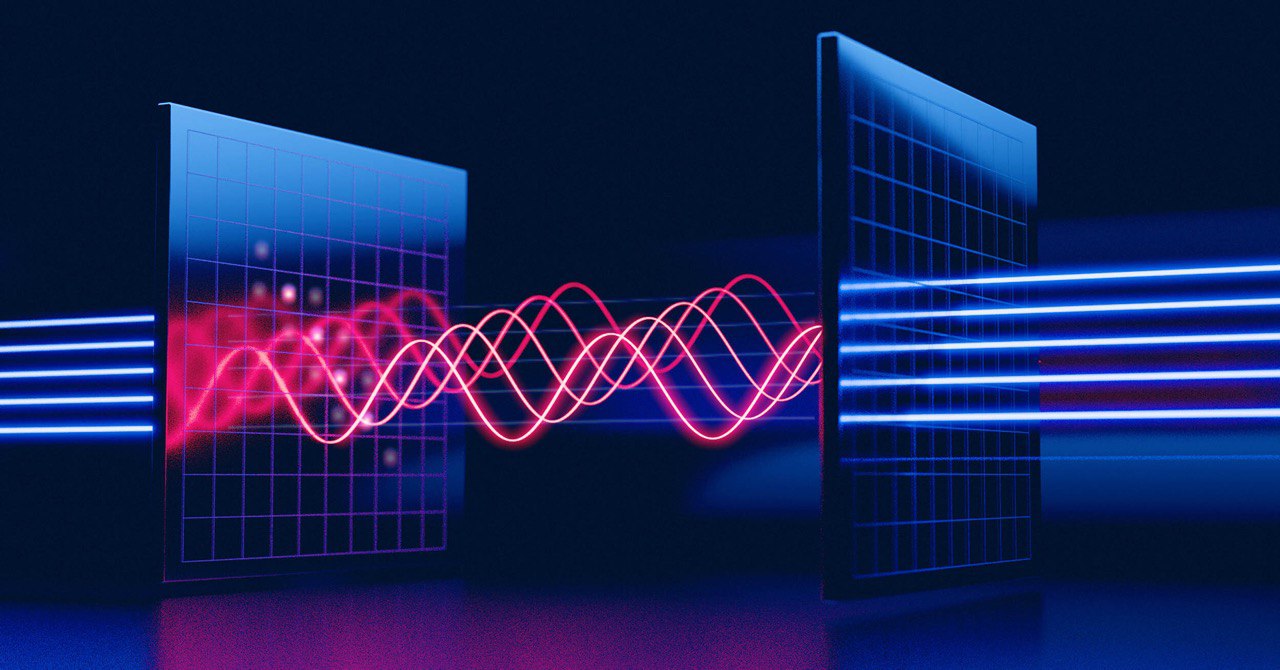Laser Processing Units could give traditional CPUs, GPUs and quantum computers a run for their money – but don’t expect them to run Windows anytime soon
By Wayne Williams
Copyright techradar

Skip to main content
Tech Radar Pro
Tech Radar Gaming
Close main menu
the business technology experts
België (Nederlands)
Deutschland
North America
US (English)
Australasia
New Zealand
View Profile
Search TechRadar
Expert Insights
Website builders
Web hosting
Best web hosting
Best office chairs
Best website builder
Best antivirus
Expert Insights
Don’t miss these
US startup set to test new CPU that could herald the era of Exaflop on a single chip – I still can’t believe Neurophos’s OPU claims to deliver 234 POPS with a 1000 Petaflops model planned
A new trick for merging lasers with silicon could finally make photonic chips cheap, fast, and ready for mass production
This chip designer you’ve never heard of reveals first thermodynamic silicon in a bid to reduce AI’s unsustainable energy consumption
Ceramic-based startup wants to put more than 100,000TB in a 42U rack by 2030 — but it will take almost 50 years to fill it up
Pizza-sized chips are the future of AI accelerators, researchers concur – but heat remains a huge problem
The next leap for the technology sector: quantum computing
Clever ‘light switch’ breakthrough could make hyperscale networks 1000x faster, just in time for AGI and superintelligence
A tiny firm wants to slash energy consumption by changing the way CPUs are designed – and it is even planning a new high performance server chip
Ex-Dyson engineer to launch LTO tape holographic rival that uses cheap $5 laser diode, promises 200TB cartridges on 100m reels — but read/write speeds are unknown
Elon Musk says xAI will have 50 million ‘H100 equivalent’ Nvidia GPUs by 2030 — but at what cost?
A Chinese GPU vendor you’ve never heard of wants to challenge Nvidia and AMD in the pro market with 24GB VRAM – surely it cannot succeed?
A chip with ‘thousands’ of cores could change the way servers are designed – bringing compute nearer to RAM thanks to CXL is a lightbulb moment
PsiQuantum plans to build world’s first large scale fault tolerant million qubit quantum computers for solving some of the world’s most complex scientific problems
States, prefectures, cities, and villages: how one tiny Japanese CPU maker is taking a radically different route to making processors with thousands of cores
OpenAI’s Sam Altman is dreaming of running 100 million GPUs in the future – 100x more than it plans to run by December 2025
Laser Processing Units could give traditional CPUs, GPUs and quantum computers a run for their money – but don’t expect them to run Windows anytime soon
Wayne Williams
20 September 2025
LightSolver’s LPU can run physics simulations with lasers
When you purchase through links on our site, we may earn an affiliate commission. Here’s how it works.
(Image credit: LightSolver)
LightSolver unveils Laser Processor Unit designed to solve physics equations at high speed
Laser computing system uses optical memory to avoid processor and memory data bottlenecks
Company begins offering early lab access with roadmap to one million variables by 2029
Laser-based computing is emerging as a potential challenger to established high-performance computing systems, with LightSolver revealing what it calls a Laser Processing Unit (LPU).
The Tel Aviv-based startup says its hardware can directly solve partial differential equations, a fundamental class of problems in physics and engineering.
Unlike quantum systems or GPU clusters, the approach is based on a grid of lasers acting in unison.
You may like
US startup set to test new CPU that could herald the era of Exaflop on a single chip – I still can’t believe Neurophos’s OPU claims to deliver 234 POPS with a 1000 Petaflops model planned
A new trick for merging lasers with silicon could finally make photonic chips cheap, fast, and ready for mass production
This chip designer you’ve never heard of reveals first thermodynamic silicon in a bid to reduce AI’s unsustainable energy consumption
Mapping equations onto the LPU
LightSolver says its hardware can map equations such as the heat equation (which models heat flow) and Schrödinger’s equation (a core equation in quantum mechanics) directly onto the LPU.
By using the natural properties of lasers as electromagnetic waves, LightSolver’s tech avoids many of the constraints found in digital systems.
This includes bottlenecks caused by data transfer between memory and processor.
According to LightSolver, the LPU operates with embedded optical memory. In practice, this means laser states are preserved inside the resonator, allowing each calculation step to build on the last without needing to move data externally.
Are you a pro? Subscribe to our newsletter
Sign up to the TechRadar Pro newsletter to get all the top news, opinion, features and guidance your business needs to succeed!
Contact me with news and offers from other Future brandsReceive email from us on behalf of our trusted partners or sponsorsBy submitting your information you agree to the Terms & Conditions and Privacy Policy and are aged 16 or over.
The result is constant-time iteration measured in nanoseconds, independent of problem size.
While LightSolver compares its platform to both high-performance and quantum computers, it stresses that it is not built on photonic chips.
Today’s photonic processors are two dimensional, whereas its laser-based design is three dimensional, which the startup argues will allow greater scalability.
You may like
US startup set to test new CPU that could herald the era of Exaflop on a single chip – I still can’t believe Neurophos’s OPU claims to deliver 234 POPS with a 1000 Petaflops model planned
A new trick for merging lasers with silicon could finally make photonic chips cheap, fast, and ready for mass production
This chip designer you’ve never heard of reveals first thermodynamic silicon in a bid to reduce AI’s unsustainable energy consumption
LightSolver has set a roadmap to reach 100,000 variables by 2027 and one million by 2029.
The company is already beginning to make its hardware available for testing. An Alpha version of its processor and a digital emulator are being offered to researchers through what it calls its LPU Lab.
LightSolver believes this step will help scientists and engineers experiment with the technology before it reaches commercial grade.
“Classical computers digitize analog nature, and we pay the price in longer run times and wasted energy. By running large-scale physics simulations on a physical machine, we can solve them more efficiently than any HPC or quantum system available today,” said Ruti Ben-Shlomi, CEO and co-founder of LightSolver.
Research papers have been published on the subject, and presentations have been given at computing conferences, including ACM Computing Frontiers 2025.
The company has also formed partnerships with simulation software providers and is working with HPC centers and national labs.
(Image credit: LightSolver)
You might also like
Why the data center of 2030 will look very different from today
Researchers find a way to address the problem of AI forgetting how to behave safely
AI is redefining university research: here’s how
Wayne Williams
Social Links Navigation
Wayne Williams is a freelancer writing news for TechRadar Pro. He has been writing about computers, technology, and the web for 30 years. In that time he wrote for most of the UK’s PC magazines, and launched, edited and published a number of them too.
You must confirm your public display name before commenting
Please logout and then login again, you will then be prompted to enter your display name.
US startup set to test new CPU that could herald the era of Exaflop on a single chip – I still can’t believe Neurophos’s OPU claims to deliver 234 POPS with a 1000 Petaflops model planned
A new trick for merging lasers with silicon could finally make photonic chips cheap, fast, and ready for mass production
This chip designer you’ve never heard of reveals first thermodynamic silicon in a bid to reduce AI’s unsustainable energy consumption
Ceramic-based startup wants to put more than 100,000TB in a 42U rack by 2030 — but it will take almost 50 years to fill it up
Pizza-sized chips are the future of AI accelerators, researchers concur – but heat remains a huge problem
The next leap for the technology sector: quantum computing
Latest in Pro
Avoiding service desk exploitation: deconstructing the modern retail attack
Could AI end web agencies as we know them? I asked the CEO of Duda
Lenovo ThinkPad X1 2-in-1 Gen 10 Aura Edition review: I tested this convertible business laptop and the pros far outweigh the cons
Nvidia gained $150 billion on Intel announcement, more than Intel market capitalization – netting a 30x return on its investment in 24 hours with just $5 billion
I visited the headquarters of Nord Security to hear how Saily is reshaping the future of travel tech – and it is even offering a free NordVPN subscription with eSIM plans
VPS servers hijacked into malware proxies – here’s how to stay safe
Latest in News
The latest DJI Osmo Nano leak gives us specs and images for the Insta360 GO 3S rival
A major Samsung One 8.5 UI leak may have revealed the next big software update headed for your Galaxy phone
How to share your Gemini Gems custom AI experts with all your friends
Anthropic’s CEO gives ‘a 25% chance things go really, really badly’ with AI
ICYMI: the week’s 7 biggest tech stories from new Meta smart glasses to stylish cheap earbuds
This iOS 26 feature is causing drama at Apple Stores for iPhone 17 trade-ins – here’s how to avoid the same mistake
LATEST ARTICLES
Laser Processing Units could give traditional CPUs, GPUs and quantum computers a run for their money – but don’t expect them to run Windows anytime soon
I’m not ashamed to love the iPhone Air
The latest DJI Osmo Nano leak gives us specs and images for the Insta360 GO 3S rival
The new DJI Mini 5 Pro drone proves you need this one feature for the best flying experience
Terrified of damaging your Nintendo Switch 2? I reviewed this cheap screen protector, and it’s all you’ll need to put your worries at rest
TechRadar is part of Future US Inc, an international media group and leading digital publisher. Visit our corporate site.
Contact Future’s experts
Terms and conditions
Privacy policy
Cookies policy
Advertise with us
Web notifications
Accessibility Statement
Future US, Inc. Full 7th Floor, 130 West 42nd Street,
Please login or signup to comment
Please wait…



